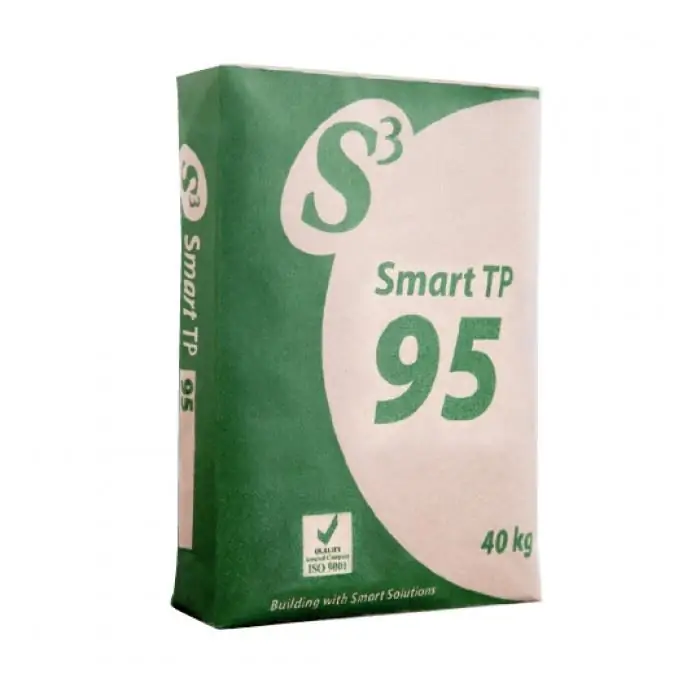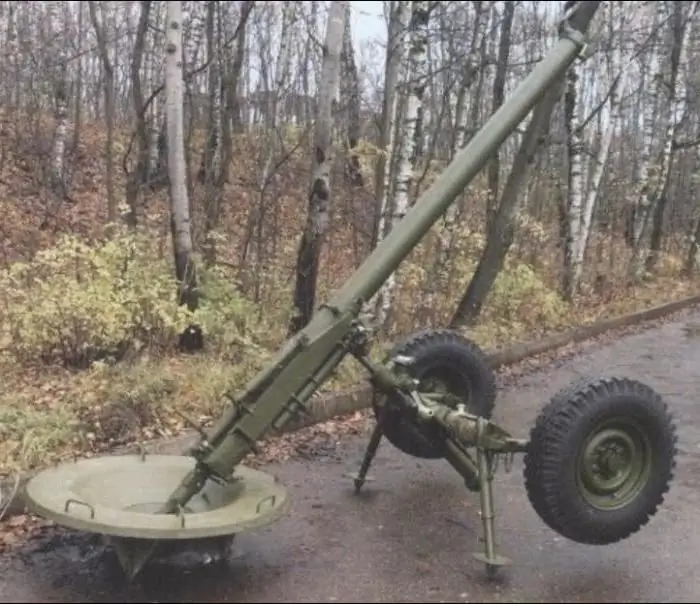2026 Author: Howard Calhoun | [email protected]. Last modified: 2025-01-24 13:10:39
Russia is a big country, in contact with the whole world. As a result, at almost every moment of time, hostilities are taking place in which the Russian military, or at least Russian weapons and armored vehicles, are involved. Having visited the Victory Parade in different cities, you can see how diverse the equipment is: artillery, tank, rocket troops, trucks and cars for a variety of purposes.

The inventors give unusual names to their equipment: the Strizh and Mig aircraft, the Grad, Smerch, Peony installations and a whole deadly bouquet of howitzers - Acacia, Hyacinth and Tulip. The Tulip howitzer is one of the beautiful flowers of artillery, let's take a closer look at it.
History of Creation
During the time of Khrushchev, the artillery troops, in principle, were declared not up to the requirements of the times. The development of rockets was required. At that time in the stage of experimental testingthere were several promising samples that pierced the armor of any tank. But it was customary to carry out the order, and the equipment was dismantled.
Something has been preserved somewhere, someone's hand did not rise to take apart their creation, and thanks to this, the SU-100P Taran anti-tank gun now stands in the famous museum of armored vehicles in Kubinka.
The Vietnam War clearly showed the lag of our artillery from the American one. The United States used the M109 installation, which hit a target at a distance of up to 14 km. They urgently began to recall old developments, to catch up with the West in the development of artillery. Then the creation of an armor-piercing bouquet was started in the Urals - "Acacia", "Hyacinth" and "Tulip" - a howitzer, the photo of which is presented below. The deadlines were given tight, and already in 1971 the machines were field tested and put into service. Since then, they have remained there, of course, with some improvements and modifications.
Purpose of the installation "Tulip"
240-millimeter self-propelled mortar mount is designed to destroy buildings and fortifications that the enemy uses as shelter for his manpower, equipment, command and communication posts, artillery, etc., inaccessible to artillery flat fire. There are no analogues in the world, howitzers and mortars of other countries have a smaller caliber and completely different characteristics.

In addition to conventional projectiles, the Tulip howitzer can fire nuclear charges while remaining at a safe distance from the explosion itself. To "Tulip"the towed 240-mm mortar M-240, which has been used since 1950, was in service. For 1971, they had similar characteristics in terms of firing and penetrating ability, but the M-240 mortar is less mobile, has less maneuverability, it takes more time to bring it into condition combat readiness, aiming and leaving the firing position.
Combat vehicle design
"Tulip" - 240 mm self-propelled mortar. The design of the installation is original. The entire artillery unit is located on the roof of the hull, the crew, ammunition and equipment are located in the chassis hull. On the left is the commander's cupola.

The ammunition includes 10 pieces of active-reactive and 20 high-explosive fragmentation mines. For all mortar processes produced for firing, a hydraulic system is provided. At his ancestor M-240, everything was done by hand. Ammunition is mechanized, drum, loading is carried out from the breech side of the barrel. There is a manual loading option with a crane.
Standard high-explosive mine F-864 has a mass of 130.7 kg, it has five bursting charges that tell the mine the speed of movement. There were reports in the Western press that active-reactive mines with nuclear charges were developed and put into production for the M-240.
The Tulip B-59 diesel engine allows speeds up to 60 km/h on asph alt and up to 30 km/h on dirt roads.
In accordance with the requirements of modern warfare, the Tulip howitzer is equipped with a protection system and can overcome the infectedterrain and act on it. The loading system and dimensions of the vehicle do not require special preparation of the position for firing.

The chassis for the mortar was used from object 305, which is very similar to the chassis of the Krug anti-aircraft complex. Armored plates "Tulip" can withstand bullets of caliber 7-62 type B-32 from a distance of 300 m.
Features
The B-59 diesel engine has a power of 520 horses and allows you to reach a maximum speed of up to 62.8 km/h. It overcomes a vertical wall of 700 mm and has a cruising range of 500 km. Also, a trench 3 m wide and a water barrier 1 m deep will not stop the Tulip.
This equipment is operated by a crew of 5 people. Self-propelled howitzer "Tulip" weighs 27,500 kg, length - about 6.5 m, width - 3 meters and a quarter, height - 3.2 m. In addition to the main gun of 240 mm, there is also an auxiliary weapon with a caliber of 7.62.

The installation can fire up to 1 shot per minute, and with a pointing and elevation angle of 80-82 degrees, a declination angle of 50 degrees, the mortar can destroy enemy objects hidden behind obstacles, while remaining out of reach. Whatever critics say, this is an effective weapon - the Tulip howitzer. The firing range of the main gun is 19 km.
Tests
All military equipment undergoes a series of tests before being put into service. Did not bypass this lot andartillery bouquet. One of the chief designers told a story about the tests of "Acacia".
During the control check, an unexpected launch of a rocket in the launcher occurred when it was in the launch position. Fortunately, there was no warhead in the rocket. Due to the starting charge, she dragged the entire installation until she hit the wall, then broke away and began to wag around the training ground, there were no casu alties. Also, "Acacia" had a problem with the removal of powder gases, they accumulated in the crew compartment. I had to create a pressure difference so that the gases would fly out after the projectile through the gun.

Howitzer "Tulip" showed its best side. They used concrete fortifications as a target, they had been shot at for many years, but thanks to their strength, they demolished everything. After the Tulip salvo, only a funnel 10 meters deep and the same width remained from them.
New howitzer shells
Mortars were modified, improved, and new shells were produced for them. It is worth mentioning one of these, mine 1K113 "Daredevil". It was developed in the late 80s. Unlike a conventional mine, it has a limited time for opening the optics window for homing and turning on the laser for target designation.
Not far from the target, at a distance of 200 to 5000 m, a spotter with a target designator is placed. It illuminates the target only when the mine is at a distance of 400-800 m. Even if the fact of target designation is detected, the enemy does not have time to respond.

A shot with such a projectile hits a target with a radius of 2-3 m with a probability of 80-90%.
"Tulip" in Afghanistan
After field tests, it was necessary to test the artillery in combat conditions. Afghanistan was the first such point. The Tulip was indispensable with its ability to hit the enemy in cover and on the other side of the mountain, fill up caves with one projectile and drop morale with impressive destruction. The advantages of the Tulip were especially noticeable during the assault on fortresses, 122-mm shells got stuck in the clay wall, while 240-mm shells destroyed everything. Thanks to the shooting angle, you can put the installation 20 m from the wall of the house, give it the maximum angle and hit the enemy who took cover on the other side of the building so that he knows what the "Tulip" is. Mortar, howitzer or just a cannon - the technical term does not matter when the shells whistle overhead.
When using the Daredevil mine, the accuracy increased, they hit directly into the entrances of the caves where the enemy was hiding.
Artillery is the god of war
In their memoirs, the military often regrets that they had little artillery, because there is never a lot of it. The heavy hooting of cannons instills confidence in one's own and presses the enemy into the ground, literally and figuratively.
Installation "Tulip" is still in service. None of the countries has a mortar of this caliber. In European countries and in the USA, the caliber does not exceed 120 mm.
Recommended:
How self-tapping screws are made at the factory: technologies and equipment. Machine for the production of self-tapping screws

How are self-tapping screws made at the factory? The answer to this question is a fairly simple technique. At the enterprises, blanks with hats are first made from steel wire. Further, threads are cut on such blanks
Self-supporting is Principles of self-supporting

Cost accounting is one of the tools that is used in solving social and economic problems. It involves the use of cost categories and indicators that are adequate to them
Polymer cement mortar: composition, technical characteristics, compliance with GOST requirements, purpose and application

Polymer cement mortar is one of the modifications of conventional sand-cement mortar. Polymers can also be added to mixtures that are used when laying plaster and other facing materials. The addition of this substance to the composition helps to improve its characteristics
Self-presentation: about yourself briefly and beautifully. Creative and beautiful self-presentation of the teacher

Today, presenting yourself to others is a daily necessity for each of us. Sometimes our partners are serious business people, sometimes they are casual acquaintances, but regardless of professions and age, we all would like to make only a positive impression
Firing range of 120 mm mortar. mortar firing range

At the dawn of the 20th century, it was time for change in the organization of military operations. While the belligerents dug in, dug multi-way trenches and fenced off with barbed wire, all the power from the use of firearms, from rifles to machine guns, and powerful gun fire could not inflict much damage on the fighters

